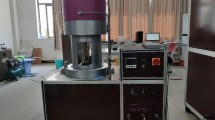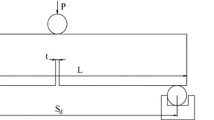Abstract
The fracture toughness of rock is very important in rock cutting, blasting, and hydraulic fracturing for tunnel excavation. To evaluate factors that reduce rock fracture toughness, we emulated the environment of joint rock in the hydro-fluctuation belt of a typical bank slope in the Shanxi Tong Chuan reservoir region. We tested long-term immersion of sandstone samples in different chemical solutions to determine the resulting mechanical characteristics and damage degradation. Variations in the physical and mechanical properties of the samples were analyzed under the effects of the chemical solutions. Experimental results show that the sandstone was significantly damaged by the chemical solutions, but its peak strain increased, and different chemical solutions had distinct influences on the degree of mechanical damage. These differences varied with the acid–base properties of the solutions. Also, there were clear consistencies among the solutions in the degree of their damage to mechanical parameters, physical parameters, and ion concentrations. Therefore, we were able to obtain correlations among the physical and mechanical parameters of the sandstone samples, damage variables, and the ion concentrations of calcium and magnesium. The surfaces of the samples were seriously degraded after being subjected to the corrosive effect of various chemicals; for example, there were different amounts of holes and pitting corrosion. The sizes of the holes and the degree of surface pitting gradually increased with an increase in corrosion time.

























Similar content being viewed by others
References
Ayatollahi, M. R., & Aliha, M. R. M. (2007). Fracture toughness study for a brittle rock subjected to mixed mode I/II loading. International Journal of Rock Mechanics and Mining Sciences,44, 617–624.
Brown, H. J., & Reddish, D. J. (1997). Experimental relations between rock fracture toughness and density. International Journal of Rock Mechanics and Mining Science,34(1), 153–155.
Chen, Y., Cao, P., & Chen, R. (2010). Effect of water–rock interaction on the morphology of a rock surface. International Journal of Rock Mechanics and Mining Sciences,47, 816–822.
Chen, M., Jin, Y., & Yuan, C. Y. (2001). Study on the experimental for fracture toughness under confining pressure. Mechanics and Engineering,23(4), 32–35.
Chen, M., & Zhang, G. Q. (2004). Laboratory measurement and interpretation of the fracture toughness of formation rocks at great depth. Journal of Petroleum Science and Engineering,41, 221–231.
Ciccotti, M., Gonzato, G., & Mulargia, F. (2000). The double torsion loading configuration for fracture propagation: An improved methodology for the load-relaxation at constant displacement. International Journal of Rock Mechanics and Mining Sciences,37(7), 1103–1113.
Cui, Z. D., Liu, D. A., An, G. M., et al. (2010). A comparison of two ISRM suggested chevron notched specimens for testing mode-I rock fracture toughness. International Journal of Rock Mechanics and Mining Sciences,47, 871–876.
Deng, H. F., Zhu, M., Li, J. L., Wang, Y., Luo, Q., & Yuan, X. F. (2012). Study of mode-I fracture toughness and its correlation with strength parameters of sandstone. Chinese Journal of Rock and Soil Mechanics,33(12), 3585–3591.
Erarslan, N., & Williams, D. J. (2012). The damage mechanism of rock fatigue and its relationship to the fracture toughness of rocks. International Journal of Rock Mechanics and Mining Sciences,56, 15–26.
Feng, X. T., Chen, S. L., & Li, S. J. (2001). Effects of water chemistry on micro cracking and compressive strength of granite. International Journal of Rock Mechanics and Mining Sciences,38(4), 557–568.
Feng, X. T., Ding, W. X., & Zhang, D. X. (2008). Multi-crack interaction in limestone subject to stress and flow of chemical solutions. International Journal of Rock Mechanics and Mining Science,46(1), 159–171.
Han, T. L., Shi, J. P., Chen, Y. S., & Cao, X. S. (2018). Quantifying microstructural damage of sandstone after hydrochemical corrosion. International Journal of Geomechanics,18(10), 04018121.
Han, T. L., Shi, J. P., Chen, Y. S., et al. (2015). Salt solution attack induced mechanical property degradation and quantitative analysis method for evolution of meso-structure damages of mortar. Chinese Journal of Materials Research,29(12), 921–930.
Heggheim, T., Madland, M. V., Risnes, R., et al. (2005). A chemical induced enhanced weakening of chalk by seawater. Journal of Petroleum Science and Engineering,46(3), 171–184.
Li, N., Zhu, Y. M., Bo, S., & Gunter, S. (2003). A chemical damage model of sandstone in acid solution. International Journal of Rock Mechanics and Mining Sciences,40(2), 243–249.
Nara, Y., Morimoto, K., Hiroyoshi, N., et al. (2012). Influence of relative humidity on fracture toughness of rock: Implications for subcritical crack growth. International Journal of Solids and Structures,49, 2471–2481.
Négrel, P., Millot, R., Roy, S., et al. (2010). Lead isotopes in groundwater as an indicator of water-rock interaction (Masheshwaram catchment, Andhra Pradesh, India). Chemical Geology,274(3–4), 136–148.
Reinhardt, H. W., & Mielich, O. (2014). Fracture toughness of alkali-sensitive rocks in alkaline solution. International Journal of Rock Mechanics and Mining Sciences,70, 552–558.
Saadaoui, M., Reynaud, P., & Fantozzi, G. (2000). Slow crack growth study of plaster using the double torsion method. Ceramics International,26(4), 435–439.
The Professional Standard Compilation Group of People’s Republic of China, DL/T5368. (2007). Specifications for rock tests in water conservancy and hydroelectric engineering. Beijing: China water Power Press. (In Chinese).
Vezzù, K., Bertucco, A., & Lucien, F. P. (2008). Numerical modelling of uniaxial compressive failure of granite with and without saline porewater. International Journal of Rock Mechanics and Mining Sciences,45(7), 1126–1142.
Wang, Y. X., Cao, P., Chen, Y., Wan, L. H., Huang, Y. H., Zhao, Y. L., et al. (2011a). Test study on damage and fracture mechanical effects for swelling soft rock during water corrosion. Journal of Central South University (Science and Technology),42(6), 1685–1691.
Wang, Q. Z., Feng, F., Ni, M., et al. (2011b). Measurement of mode I and mode II rock dynamic fracture toughness with cracked straight through flattened Brazilian disc impacted by split Hopkinson pressure bar. Engineering Fracture Mechanics,78(12), 2455–2469.
Wu, X. D. (2013). Experimental study on the time-dependent behaviour of Xiangjiaba sandstone. Applied Mechanics and Materials,256–259, 174–178.
Zhang, Z. X. (2002). An empirical relation between mode I fracture toughness and the tensile strength of rock. International Journal of Rock Mechanics and Mining Sciences,39(3), 401–406.
Zhang, S., & Wang, Q. Z. (2009). Determination of rock fracture toughness by split test using five types of disc specimens. Rock and Soil Mechanics,30(1), 12–18. (In Chinese).
Zhang, F. C., Wang, X. C., Lu, J., et al. (1981). Fracture mechanics (pp. 49–56). Beijing: China Architecture and Building Press.
Zhang, S., Wang, Q. Z., & Xie, H. P. (2008). Size effect of rock dynamic fracture toughness. Explosion and Shock waves.,28(6), 544–551.
Acknowledgements
The authors gratefully acknowledge the support of the National Natural Science Foundation of China (Nos. 11302167, 11572244, and 51478272), the joint funds of the National Natural Science Foundation and Guangdong Province of China (U1301241), the International Cooperation and Exchange of the National Natural Science Foundation of China (51520105012), and the Collaborative Innovation Research Centre for Environment-Friendly Materials and Structures in Civil Engineering, Southeast University, the Science and Technology Foundation for the Basic Research Plan of Shenzhen City (JCYJ20160422095146121).
Author information
Authors and Affiliations
Corresponding author
Additional information
Publisher's Note
Springer Nature remains neutral with regard to jurisdictional claims in published maps and institutional affiliations.
Rights and permissions
About this article
Cite this article
Han, T., Shi, J., Chen, Y. et al. Mechanism Damage to Mode-I Fractured Sandstone from Chemical Solutions and Its Correlation with Strength Characteristics. Pure Appl. Geophys. 176, 5027–5049 (2019). https://doi.org/10.1007/s00024-019-02237-w
Received:
Revised:
Accepted:
Published:
Issue Date:
DOI: https://doi.org/10.1007/s00024-019-02237-w




